CompositesWorld News for Dec. 06, 2019
Read news from AnalySwift, Polynt Composites, Composites One, and SGL Carbon SE
Dowty Propellers opens U.K. production facility, repair operation and headquarters
The Brockworth, England facility will include a full production facility for the company’s aircraft propeller systems featuring all-composite blades.
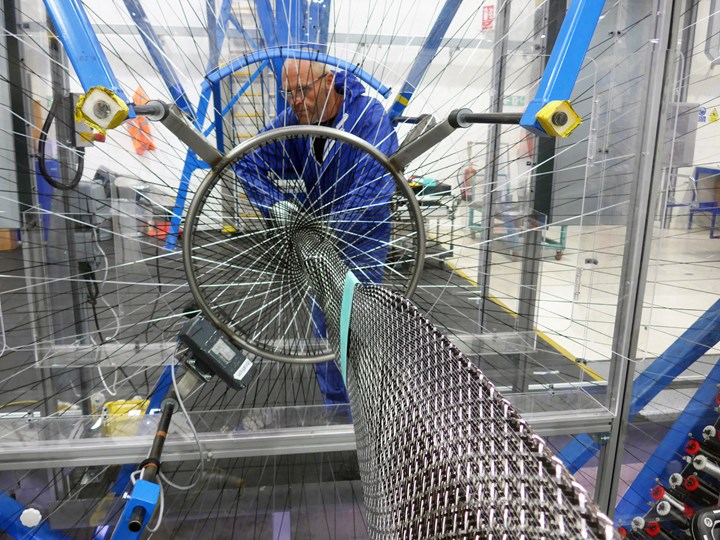
Dowty Propellers’ use of braiding machines in the manufacture of composite propeller blades enhances productivity and quality. Two braiding machines acquired by Dowty Propellers are being set up at the company’s new production facility, repair operation and headquarters in Brockworth, England. Source | Dowty Propellers
On Dec. 4, Dowty Propellers (Gloucester, U.K.), a business of GE Aviation, inaugurated a new facility in Brockworth, England that will serve as the company’s headquarters, U.K. repair and overhaul center and the full production facility for its aircraft propeller systems featuring all-composite blades. The new center is expected to be fully operational in the first half of 2020.
The Brockworth facility replaces the company’s original headquarters and blade manufacturing facility in Gloucester that was destroyed by fire in February 2015. Technologies will be incorporated for production, control, repair and in-service support of Dowty’s propeller systems, which are used on turboprop and turboshaft engines powering regional airliners and military airlifters, along with amphibious aircraft and marine hovercraft. The company is transferring its current equipment, located at an interim blade manufacturing facility in Mitcheldean, U.K.

Dowty Propellers inaugurated its new production facility, headquarters and repair operation in Brockworth, England, on Dec. 4, 2019. The event was attended by the company’s customers, government representatives and its employees. Source | Dowty Propellers
Dowty Propellers says it was able to continue its supply and support operations after the fire, enabling airframers to maintain production lines for new-build airplanes and keeping existing fleets in the air, including Lockheed Martin’s C130J Super Hercules airlifters and De Havilland Aircraft of Canada’s Dash 8-400 regional airliners. Dowty Propellers cites parent company GE Aviation’s resources as essential to its post-fire recovery efforts.
The U.K. Dowty Propellers Repair and Overhaul (DPRO) center — which previously had operated at a separate location in Gloucester — will now be integrated into the new Brockworth facility. There also are DPRO centers in Sterling, Virginia, U.S., and Brisbane, Australia, as well as a team of field service engineers that are deployed around the world for field repairs.

The injection of a foam core is part of Dowty Propellers’ production process for its high-technology composite blades, giving structural rigidity for the blade with a lightweight filling. Shown here is the injection process at Dowty Propellers’ Mitcheldean interim production site, prior to the transfer of equipment to the Gloucester Business Park in Brockworth. Source | Dowty Propellers
“The new facility offers a unique opportunity to realize the benefits of the significant investments made in recent years in the new technologies and advanced manufacturing techniques that will support the development of more-efficient and lower-noise propellers,” says Gary Elliott, CEO of the Aerospace Technology Institute, which creates the technology strategy for U.K. aerospace, and funds research and development.
“We are pleased to support the DigiProp program and Dowty Propellers’ state-of-the-art research to find ways to increase the efficiency and reduce the noise footprint of what is already an inherently efficient propulsion system. Propellers have a great future as we need ever more efficient aircraft, including their application in hybrid and electric-powered solutions,” Elliott adds.
“Dowty Propellers’ efforts over the past four years not only represent its commitment to the exciting future of propellers, but also its commitment to providing world-class products and solutions for its global customer base,” says Brad Mottier, GE Aviation’s vice president and general manager of business and general aviation & integrated systems. “With this state-of-the-art facility, Dowty Propellers is poised to continue its leadership in this industry with sustainable, smart technologies and a driven, dedicated workforce.”
AC Marine & Composites to build composite blades for 2-MW tidal turbine
The 2-megawatt tidal turbine will feature four 10-meter composite blades, and is expected to be the most powerful tidal turbine to date.

The O2 2-megawatt tidal turbine. Source | Orbital Marine Power Ltd.
AC Marine & Composites Ltd. (ACMC; Gospart, U.K.) has been awarded a contract to supply composite blades for floating tidal stream turbine developer Orbital Marine Power Ltd.’s (Orbital; Orkney and Edinburgh, U.K.) first commercial O2 tidal turbine. ACMC will manufacture the blades at its facilities in Gospart, Hampshire, U.K.
According to Orbital, ACMC will build 10-meter composite blades for both of the O2’s twin rotors, with four blades in total, giving the machine a swept area of more than 600 square meters. Orbital says this is the largest ever on a tidal turbine.
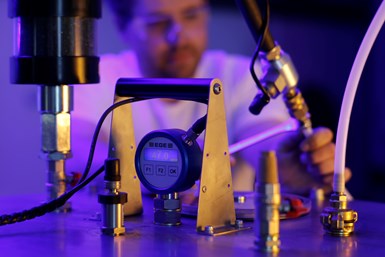
Bespoke resin injection machine from AC Marine & Composites. Source | Orbital Marine Power Ltd.
The O2, capable of generating more than 2 megawatts of power from tidal stream resources, will reportedly become the world’s most powerful tidal turbine when it enters operation later next year as part of a long-term project at the European Marine Energy Centre in Orkney, Scotland. Improvements in Orbital’s platform design have allowed for a rotor diameter increase of 4 meters on the company’s previous, record-breaking 2-megawatt SR2000 turbine, and the O2 will be capable of producing electricity for more than 1,700 U.K. homes.
“AC Marine & Composites have an impressive track record in delivering high-quality composites solutions to a range of sectors including marine energy. We are delighted that they are supporting the commercialization of our technology through the O2 project,” says Andrew Scott, CEO of Orbital.
Carleton University leverages VABS software for helicopter blade simulation
As part of AnalySwift LLC’s Academic Partner Program, Carleton University is working on new comprehensive software to simulate helicopter blade tasks.
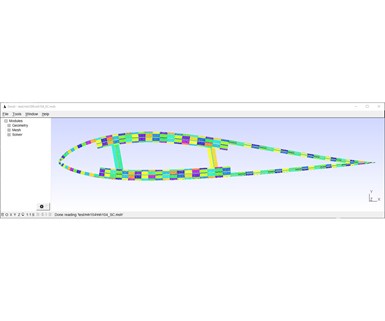
Source | AnalySwift LLC
AnalySwift LLC (West Jordan, Utah, U.S.), a provider of efficient high-fidelity modeling software for composites, announced on Dec. 3 that Carleton University (Ottawa, Ontario, Canada) is participating in its recently launched Academic Partner Program (APP) and is using its VABS simulation software for simulating new helicopter rotor blades. The work is part of the Rotorcraft Laboratory at Carleton University, a research group working on new comprehensive software for helicopters in order to study various tasks such as aerodynamics, structural dynamics, flight mechanics and control.
Supervised by Dr. Fred Nitzsche, professor in the Mechanical and Aerospace Department, over the past 20 years, the Rotorcraft Laboratory collaborates with several European universities to accomplish these tasks.
“We are excited by the work being done by Carleton University and are pleased they have selected VABS as part of their composite helicopter rotor blade simulation workflow,” says Allan Wood, president & CEO of AnalySwift.
The Academic Partner Program (APP) is designed to offer participating universities no-cost licenses of its engineering software programs VABS and SwiftComp so that students, researchers and faculty can leverage the tools in their academic research. AnalySwift says the program also affords students an additional avenue to highlight their research, as AnalySwift periodically spotlights papers, theses and articles involving the codes. The company has also established a robust community of users who can help answer questions through the online cdmHUB (composite design & manufacturing HUB) platform.
According to the company, the VABS program is a general-purpose cross-sectional analysis tool for computing beam properties and recovering 3D stresses and strains of slender composite structures. It is a tool for rigorously modeling composite helicopter and wind turbine rotor blades, as well as other slender structures such as propellers, landing gear and high-aspect ratio wings.
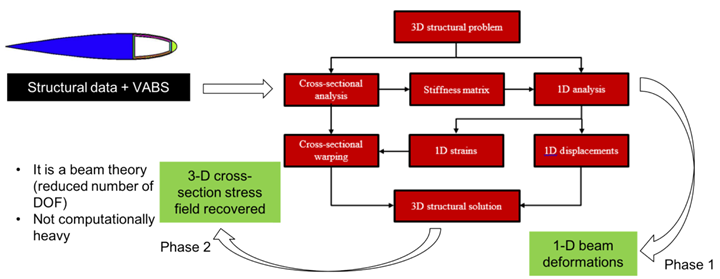
Flowchart showing the relation between VABS and the current task. Source | Carleton University
“Many helicopter and wind turbine blades are made of composite materials and have relatively complex geometry,” says Dr. Ali Siami, postdoctoral fellow in the Mechanical and Aerospace Department of Carleton University. “In order to model them correctly, the structural properties of these blades should be extracted thoroughly. VABS, which calculates the structural properties of blades, will be used in this project to accomplish this. The results of this project will be used to design rotorcraft with more realistic models that are provided in the new developed software. The results can also be extended to wind turbines.”
“The VABS program is a uniquely powerful tool for modeling composite blades, high aspect ratio wings, and other slender structures, commonly called beams,” says Dr. Wenbin Yu, chief technical officer of AnalySwift. “VABS reduces analysis time from hours to seconds by quickly and easily achieving the accuracy of detailed 3D finite element analysis (FEA) with the efficiency of simple engineering models. With VABS, engineers can calculate the most accurate, complete set of sectional properties such as torsional stiffness, shear stiffness, shear center for composite beams made with arbitrary cross-section and arbitrary material. It can also predict accurate detailed stress distribution for composite beams, which are usually not possible with 3D finite element analysis (FEA) for realistic composite structures.”
Composites One acquires Polynt Composites Distribution
Canadian-based Polynt Composites Distribution manufactures thermoset resins, gel coats and other raw materials focused on the composites market.

Composites One President and COO Leon Garoufalis announced the company’s acquisition of Polynt Composites Distribution to employees and customers on Dec. 2, 2019.
North American composites raw materials supplier and services provider Composites One (Arlington Heights, Ill., U.S.) has announced that it has closed on the purchase of Canadian-based Polynt Composites Distribution from Polynt-Reichhold Group, a North American manufacturer of thermoset resins, gel coats and other raw materials focused on the composites market.
According to Composites One, Polynt Composites will continue to own and operate its resin and gel coat blending operations in Brampton, Ontario and Drummondville, Quebec, to provide these products to Composites One and the market.
“This divestiture reflects Polynt-Reichhold’s commitment to concentrate its resources on manufacturing industry leading resins, gel coats and other specialties, while maintaining a critical channel to market through our important distribution partner, Composites One,” says Harold Visser, executive vice president Americas.
“Composites One has been committed to expanding our business by providing real value to our customers. By combining the talented and experienced people from both organizations, we are creating an even stronger platform to service Canadian customers who produce products using advanced and traditional composites products and processes. Our goal with this acquisition is to provide all of our customers in Canada with the products, support and service to help them to grow their businesses and be successful,” says Leon Garoufalis, president and chief operating officer of Composites One.
SGL Carbon, Hyundai Motor Group extend partnership for fuel cell components
The extension ramps up current production and delivery volumes of SGL Carbon’s SIGRACET gas diffusion layers for Hyundai fuel cell-powered vehicles.
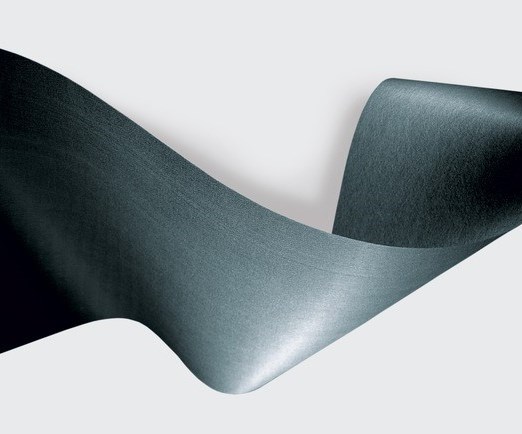
SGL Carbon's SIGRACET gas diffusion layer. Source | SGL Carbon
SGL Carbon (Wiesbaden, Germany) and the Hyundai Motor Group (Seoul, South Korea) announced Dec. 4 that they have extended their supply agreement for production of gas diffusion layers for Hyundai’s NEXO fuel cell cars. The long-term agreement is said to provide for a substantial ramp-up of current production and delivery volumes. However, the investment required to fulfill this contract will not increase the overall capital expenditure budget of SGL Carbon in the next two years, as the company has reprioritized its investment projects.
SGL Carbon plans to more than quintuple its business — from its current business of around 200 customers — with its gas diffusion layer fuel cell components, to annual sales of approximately €100 million (more than $110 million USD). As a result of growing demand, the company says it has gradually stepped up production capacity at its plant in Meitingen, Germany, and is now equipped to manufacture fuel cell components on an industrial scale. In addition, to further advance accelerated commercialization, the gas diffusion layers business will be transferred from the central R&D department Central Innovation (CI) to the business unit Graphite Materials & Systems (GMS) in the fourth quarter of 2019.
SGL Carbon says it has been carrying out research and development into components for fuel cells since the 1990s. The gas diffusion layers regulate the flow of gas within the fuel cell and carry water and heat away and are said to have a significant impact on the power density and efficiency of the fuel cell. SIGRACET gas diffusion layers from SGL Carbon were first used as a standard in the Hyundai iX35 in 2012.
“The extension of the partnership with Hyundai is perfectly aligned to our strategic direction. Intelligent solutions in the area of sustainable energy are one of the key growth drivers for our company,” says Dr. Michael Majerus, spokesman of the board of management of SGL Carbon. “Whether used in a drive system in vehicles or as a stationary power supply, the fuel cell is one of the greenest energy technologies around. The market for fuel cells thus offers enormous potential for us.”
Related Content
Materials & Processes: Resin matrices for composites
The matrix binds the fiber reinforcement, gives the composite component its shape and determines its surface quality. A composite matrix may be a polymer, ceramic, metal or carbon. Here’s a guide to selection.
Read MoreJEC World 2022, Part 3: Emphasizing emerging markets, thermoplastics and carbon fiber
CW editor-in-chief Jeff Sloan identifies companies exhibiting at JEC World 2022 that are advancing both materials and technologies for the growing AAM, hydrogen, automotive and sustainability markets.
Read MoreNovel dry tape for liquid molded composites
MTorres seeks to enable next-gen aircraft and open new markets for composites with low-cost, high-permeability tapes and versatile, high-speed production lines.
Read MoreMaterials & Processes: Composites fibers and resins
Compared to legacy materials like steel, aluminum, iron and titanium, composites are still coming of age, and only just now are being better understood by design and manufacturing engineers. However, composites’ physical properties — combined with unbeatable light weight — make them undeniably attractive.
Read MoreRead Next
Composites end markets: Energy (2024)
Composites are used widely in oil/gas, wind and other renewable energy applications. Despite market challenges, growth potential and innovation for composites continue.
Read MoreCW’s 2024 Top Shops survey offers new approach to benchmarking
Respondents that complete the survey by April 30, 2024, have the chance to be recognized as an honoree.
Read MoreFrom the CW Archives: The tale of the thermoplastic cryotank
In 2006, guest columnist Bob Hartunian related the story of his efforts two decades prior, while at McDonnell Douglas, to develop a thermoplastic composite crytank for hydrogen storage. He learned a lot of lessons.
Read More













.jpg;maxWidth=300;quality=90)











